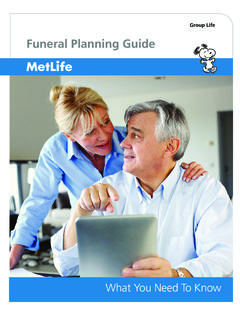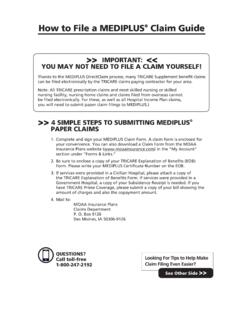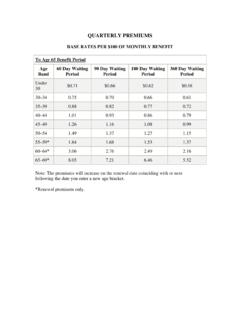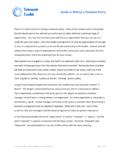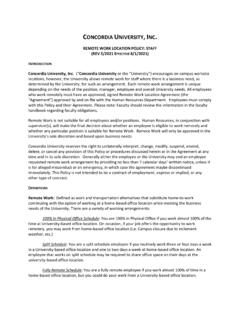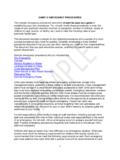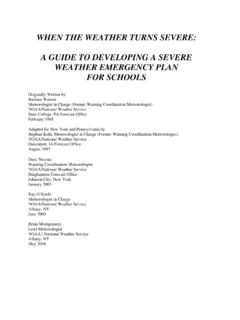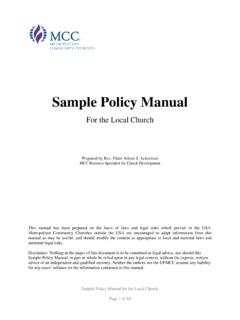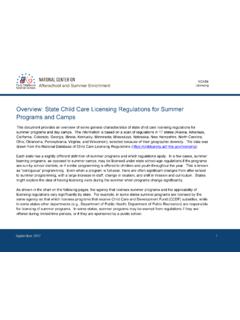Transcription of FLEET MANAGEMENT POLICY Fleet Management …
1 FLEET MANAGEMENT POLICY FLEET MANAGEMENT overview It is the POLICY of _____ to safely operate company vehicles in adherence with all applicable laws and regulations. This FLEET POLICY reflects the requirements and standards to effectively manage our FLEET of company vehicles. FLEET Driver Only authorized individuals may drive a company vehicle. All drivers must meet minimum standards as established by applicable regulatory agencies, the company and its insurance provider. Authorization to drive a vehicle may be denied or revoked. Use of company vehicles is limited to official business and personal use is strictly limited and requires prior approval. Drivers and passengers must comply with all applicable laws and company policies. Drivers are responsible for paying all vehicle citations. Additionally, drivers are responsible for immediately reporting all accidents or any damage to company vehicles.
2 Special Certifications & Licenses Depending upon the type of vehicle driven, special training and/or licensing may be required prior to vehicle use. Drivers may be subject to Department of Transportation (DOT) / Federal Motor Carrier Safety Administration (FMCSA) regulations. Additionally, select vehicles may require Commercial Drivers Licenses (CDL) for operation. Commercial Driver License (CDL) Requirements Only CDL drivers are permitted to drive the following types of vehicles or combination of vehicles. There is absolutely no exception to this POLICY and violations will result in immediate termination and potential prosecution of violation of federal law. Any vehicle with a semi-trailer or trailer with two or more axles is a Class A CDL vehicle. This group also includes any combination of vehicle with a gross vehicle weight rating greater than 26,000 pounds, provided that the gross vehicle weight rating of the towed vehicle is in excess of 10,000 pounds.
3 Any Heavy Straight Vehicle with a gross vehicle weight rating greater than 26,000 pounds is a Class B CDL vehicle, as well as any vehicle towing another vehicle not in excess of 10,000 pounds. Any vehicle that is designed to transport 16 or more passengers (including the driver) or is used in the transportation of materials classified as hazardous in the Hazardous Materials Transportation Act is a Class C CDL vehicle. A driver with a CDL hired by the company must be drug tested prior to driving a company vehicle and may be subject to random testing. A driver receiving a CDL after employment is required to be drug tested prior to driving a company vehicle. The driver is responsible to ensure that the vehicle meets State and Federal regulations regarding permits, safety devices, equipment ( , pre-trip inspections) and loads prior to operating vehicle.
4 The driver must also comply with all applicable State and Federal regulations. Driver Minimum Qualification Standards The following minimum standards are required for driver authorization: Must have a valid operator s license; Must have minimum of two years licensed driving experience; 1. FLEET MANAGEMENT POLICY Must be 21 years of age (DOT Must have an appropriate Medical Examiner s Certificate (DOT Must be capable of successfully passing a written rules examination; Must be capable of successfully passing a roadway driving test; Must not have more than 2 minor moving violations within the past 3 years; Must not have had any felony convictions within the past 7 years; Must not have had any DUI/DWI convictions within the past 3 years. Exceptions to the minimum standards must be requested from Executive MANAGEMENT for approval.))
5 Approval of such requests will be documented and kept on file. All requests for exceptions to the minimum standards must be justified and validated. Required Training Drivers must be trained on each specific type of vehicle to be driven. The training is to be conducted by an authorized and qualified individual designated by executive MANAGEMENT . That training must include, but is not limited to: Pre-Trip Inspections Location & Use of Vehicle Controls Emergency Equipment & Procedures Load Securement Safety Limitations ( braking distances, turning radius, blind spots, etc.) Trailers & Attachments The training is to be accompanied by a road test to ensure the driver has sufficient knowledge and understanding of safe vehicle operation. A Certificate of Driver s Road Test should be issued upon successful completion.
6 A copy of the certificate must be kept in the driver s personnel file. Drivers who have had less than 2 years of commercial driving experience must be paired with an experienced driver for a period of no less than 2 weeks to ensure vehicle acclimation. Driver Disqualification Authorized drivers are disqualified from operating a company vehicle if their driving record reflects any of the following conditions: 2 or more moving violations and/or at-fault accidents in the past 3 years; A DUI/DWI citation within 12 months; Suspension or revocation of driver s license. The violation occurs when the citation is issued, not when the final court decision is made. It is the responsibility of drivers to inform Dispatch when they have received a moving violation or have been involved with at-fault accidents.
7 Any change in the status of a driver s record resulting in disqualification or the failure to report such change may result in revocation of the privilege of driving a company vehicle and/or discipline up to and including discharge. Exceptions to this POLICY are subject to review by Executive MANAGEMENT and are final. Additionally, DOT & CDL drivers may be disqualified if there is a change in their health status that disqualifies them according to federal guidelines. It is the responsibility of the driver to notify Dispatch of any changes to their medical conditions that may disqualify them from operating a DOT or CLD vehicle. DOT & CDL drivers must pass a medical examination conducted by a licensed healthcare professional every 2 years. 2. FLEET MANAGEMENT POLICY Furthermore, drivers are disqualified if they test positive for a controlled substance, including illegal drugs, prescription medications that impair driver performance, and alcohol.
8 Drivers have a responsibility to inform Dispatch when they are taking prescription medications that may impair their ability to safely operate vehicles. Permitted and Prohibited Uses of Company Vehicles The following policies govern the use of company vehicles: Use of a company vehicle must be for official company business only. Personal use associated with official business is strictly limited and should be approved prior to use. All drivers and passengers in company vehicles must comply with all applicable state laws. Seatbelts must be used by the driver and passengers at all times the vehicle is engaged. There is absolutely no exception to this mandate and violations are subject to immediate termination. Drivers are personally responsible for the cost of all traffic citations, parking tickets, locksmith calls for retrieving keys, etc.
9 Compliance with the company FLEET MANAGEMENT POLICY , state and federal laws is required of all drivers and passengers. No person may use a company vehicle, or permit the use of a company vehicle, in the following prohibited manners: Reckless driving or speeding; Participation in distracting activities, including, but not limited to: o Sending Text Messages o Reading Emails or Text Messages o Smoking o Eating o Reading of Maps or Directions Transportation of non-authorized individuals, including family members, friends, hitchhikers, etc.; Personal gain such as delivering goods and/or services; Modifications of vehicles or tampering with stickers, decals, etc. Transportation of animals or pets; Hauling loads that could structurally damage the vehicle or trailers; Improper use of trailer hitches and/or towing equipment; Use of radar detection devices; Drivers may not operate company vehicles if they are impaired by fatigue, prescription medications, alcohol, drugs or any other condition.
10 Any such vehicle use will be considered a violation of the FLEET MANAGEMENT POLICY and may be grounds for disciplinary action up to and including termination. Drivers of company vehicles who feel that their driving abilities may be impaired must cease operating the vehicle immediately. Employees who believe another employee is impaired have a duty to prevent that person from driving a company vehicle. Employees are only to use cellular phones (including blue tooth and hands-free phones), two-way radios, etc. for official company purposes while operating vehicles. Conversations should be limited to avoid driver distraction. It is preferred that drivers find a safe location to pull vehicles off the road to use communication devices. Additionally, it is the responsibility of the dispatcher and driver to assess roadway and climatic conditions to select routes that reduce risk exposures.



